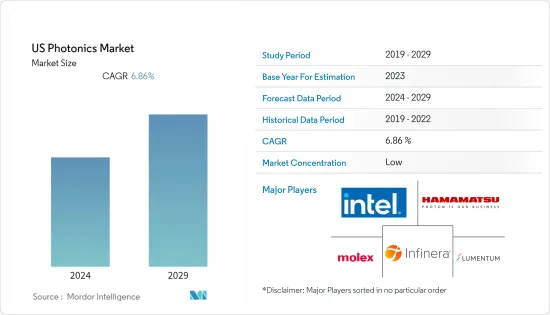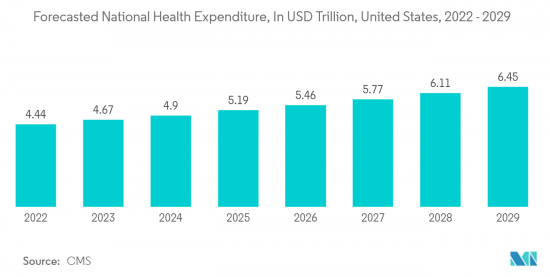PUBLISHER: Mordor Intelligence | PRODUCT CODE: 1407079

PUBLISHER: Mordor Intelligence | PRODUCT CODE: 1407079
US Photonics - Market Share Analysis, Industry Trends & Statistics, Growth Forecasts 2024 - 2029

The United States photonics market was valued at USD 111.07 billion the previous year and is expected to register a CAGR of 6.86%, reaching USD 159.83 billion by the next five years.
Key Highlights
- Photonics is widely regarded as a critical enabling technology for developing smart systems that make efficient use of energy without sacrificing overall system efficiency. Many verticals, including healthcare, automotive, communications, manufacturing, and retail, are leveraging the technology to attain higher efficiency, driving growth.
- Investments from these sectors also have witnessed significant growth in the recent past. With photonics being a core technology of multiple industries, the consumption of the technology is witnessing rapid growth, with the market expanding in new verticals.
- Over the past few years, there has been an increasing trend of LiDAR or additive manufacturing in photonics. LiDAR has been used to study the atmosphere's distribution of gases and contaminants for decades. In recent years, it has become a critical technology for autonomous driving.
- The advancements in LiDAR mapping systems and their enabling technologies penetrated different verticals, like aerospace and defence, corridor mapping and topographical survey, automotive, mining, oil and gas, and other verticals, which are increasing the scope of the market.
- The presence of industry giants such as Google, Microsoft, and Facebook is the primary force driving the US market, necessitating optimization of the data transmission process for respective data centers. The country also provides a favorable environment for technological advancements and expansions. Furthermore, the significant funding landscape in the US silicon photonics devices industry has encouraged organizations and start-ups to invest in the expanding photonics market.
- However, compared to conventional products, the high initial cost of silicon-enabled photonic products and devices hinders technology deployment in many fields. While the technology provides higher performance and efficiency, photonics-based devices remain inaccessible to many small- and medium-sized end-users in various verticals due to limited budgets.
- The COVID-19 pandemic influenced the overall semiconductor manufacturing market from the demand and supply sides. In addition, the global lockdowns and closure of semiconductor plants also fueled the supply shortage. The effects were also reflected in the studied market. However, many of these effects were short-term. Precautions by governments worldwide to support automotive and semiconductor sectors helped revive industry growth.
US Photonics Market Trends
Emergence of Silicon-based Photonics Applications to Drive the Market
- Silicon photonics is an evolving branch of photonics, offering a clear advantage over electric conductors used in semiconductors, which are used in high-speed transmission systems. This technology is expected to push the transmission speed up to 100 Gbps, with companies like IBM, Intel, and Kothura, achieving breakthroughs. Besides, this technology is revolutionizing the semiconductor industry, enabling high-speed data transfer and processing.
- Moreover, silicon-based photonics provides energy-efficient data transmission and processing solutions, making it suitable for applications where power consumption is a concern, such as data centers and high-power computing.
- The growth in internet traffic is not only accelerating the need for next-generation technology to support higher port density and faster speed transitions but is also accompanied by large physical data center sizes and faster connectivity between the data centers. As the data rates and distances to carry high-speed data are increasing, the limitations of traditional copper cable and multimode fiber-based solutions are becoming apparent, and the industry is shifting towards adopting single-mode fiber-optic solutions.
- Silicon-based photonics is expected to play a significant role in the evolution of data centers in the short term for 100G and then 400G and 800G pluggables. It will also be an enabling technology for disaggregating data centers and a possible future CPO approach. The technology is increasingly used for 500 m reach DR-standard connections but is also used with coherent technology in datacom applications. Moreover, the market is also witnessing increasing demand for 400ZR standard technology.
- Additionally, with the rising implementation of silicon photonics in medical applications, many start-ups have started using silicon-integrated optics as a manufacturing platform. According to US Census Bureau, the industry revenue of medical equipment and supplies manufacturing in the United States is expected to reach USD 43.51 billion by 2023. Whereas the national health expenditure in the country is expected to reach USD 7.174 trillion by 2031, which was USD 4.439 trillion in 2022, as stated by CMS.
- Consumer health development continues, with Rockley announcing the shipment of its VitalSpexTM biosensing platform in 2022-23. Such trends are expected to boost the integration of silicon photonics-based biosensors in wearables from prominent brands like Apple or Huawei.

Data Communication Application Segment is Expected to Hold Significant Market Share
- The growing use of optical solutions in communication technologies, such as optical broadband, is expected to drive the demand for technology in the market, with the segment commanding a prominent market share.
- As the growing use of optical networks is part of the infrastructure, the investment from telecommunication companies in enhancing the legacy networks is expected to drive the demand. Telephone companies were the first to replace their old copper wire systems with optical fiber lines. Telephone companies use optical fiber as the backbone architecture and a long-distance connection between the city phone systems.
- Moreover, with the proliferation of technologies and the growing consumption of video content over the Internet, the demand for broadband is increasing worldwide. According to TeleGeography's submarine cable map, submarine cables act as the backbone of the Internet. Moreover, according to the US Naval Institute, of more than 400 fiber optics undersea cables, the United States is connected to the world through approximately 88, including 17 scheduled to be completed between 2022 and 2024.
- According to Global System for Mobile Communications (GSMA), the 5G penetration in the United States is expected to overtake 4G by 2025. In addition, the government is allocating several funds for the faster deployment of 5G services in the region. In April 2023, the Biden-Harris Administration launched the Public Wireless Supply Chain Innovation Fund, which will invest USD 1.5 billion to develop open and interoperable networks. The initial round of funding will help to ensure that the future of 5G and next-gen wireless technology is built by the United States and its global allies and partners.
US Photonics Industry Overview
The United States photonics market comprises several global and regional players vying for attention in a contested market space. Market incumbents, such as Finisar Corporation, Intel Corporation, NeoPhotonics Corporation, Infinera Corporation, Hamamatsu Photonics, IPG Photonics Corporation, and Coherent Inc., have a considerable influence on the overall market, with access to well-established distribution networks.
The existence of such a sheer number of significant vendors without compromising on their market shares is sustainable. Brand identity associated with major vendors became a synonym for various product offerings under the scope of the study worldwide. Overall, the intensity of competitive rivalry among the vendors in the market studied is expected to be high and remain the same during the forecast period.
In July 2023, ams OSRAM launched EVIYOS 2.0, a new type of intelligent multipixel light emitting diode (LED) that enables fully adaptive, dynamic headlight operation and image projection for the automotive sector. EVIYOS 2.0 can selectively illuminate the road ahead to maximize the driver's view in high-beam mode without creating the glare typically experienced by other road users.
In January 2023, Hamamatsu Photonics developed a new InAsSb photovoltaic detector (P16702-011MN) with a preamp offering high sensitivity to mid-infrared light, up to 11 micrometers (µm) in wavelength. The company combined the latest InAsSb(indium arsenide antimonide) mid-infrared detector with its unique circuit design technology. Compared to its previous detector modules with the same level of sensitivity, the P16702-011MN size and cost are drastically reduced, and it exhibits a fast response time. This makes it an ideal choice for portable gas analyzers to immediately analyze exhaust gas components at measurement sites around factories.
Additional Benefits:
- The market estimate (ME) sheet in Excel format
- 3 months of analyst support
TABLE OF CONTENTS
1 INTRODUCTION
- 1.1 Study Assumptions and Market Definition
- 1.2 Scope of the study
2 RESEARCH METHODOLOGY
3 EXECUTIVE SUMMARY
4 MARKET INSIGHTS
- 4.1 Market Overview
- 4.2 Industry Attractiveness - Porter's Five Forces Analysis
- 4.2.1 Bargaining Power of Suppliers
- 4.2.2 Bargaining Power of Buyer/Consumers
- 4.2.3 Threat of New Entrants
- 4.2.4 Threat of Substitutes
- 4.2.5 Intensity of Competitive Rivalry
- 4.3 Industry Value Chain Analysis
- 4.4 An Assessment of the Impact of Key Macroeconomic Trends
5 MARKET DYNAMICS
- 5.1 Market Drivers
- 5.1.1 Emergence of Silicon-based Photonics Applications
- 5.1.2 Increasing Focus on High-performance and Eco-Friendly Solutions
- 5.2 Market Challenges/Restraints
- 5.2.1 High Initial Cost of Photonics - Enabled Devices
6 MARKET SEGMENTATION
- 6.1 By Application
- 6.1.1 Surveying And Detection
- 6.1.2 Production Technology
- 6.1.3 Data Communication
- 6.1.4 Image Capture and Display
- 6.1.5 Medical Technology
- 6.1.6 Lighting
- 6.1.7 Other Applications
7 COMPETITIVE LANDSCAPE
- 7.1 Company Profiles
- 7.1.1 Intel Corporation
- 7.1.2 Neophotonics Corporation (lumentum Holdings)
- 7.1.3 Infinera Corporation
- 7.1.4 Molex Inc.
- 7.1.5 Hamamatsu Photonics KK
- 7.1.6 IPG Photonics
- 7.1.7 Coherent, Inc. (Coherent Corp.)
- 7.1.8 Vescent Photonics LLC
- 7.1.9 Photonic Systems Inc.
- 7.1.10 Thorlabs Inc.
- 7.1.11 NEC Corporation
- 7.1.12 ams OSRAM AG
- 7.1.13 Trumpf Group
- 7.1.14 Polatis Incorporated (huber+suhner)
- 7.1.15 Alcatel-lucent SA (Nokia Corporation)
8 EMPLOYEE SCENARIO - PHOTONICS INDUSTRY
9 MARKET OUTLOOK




